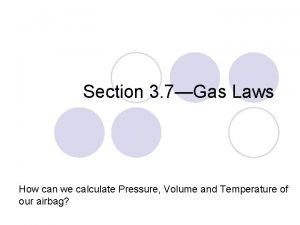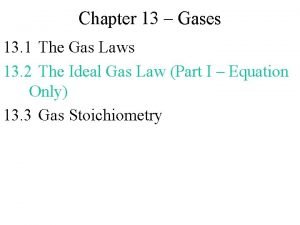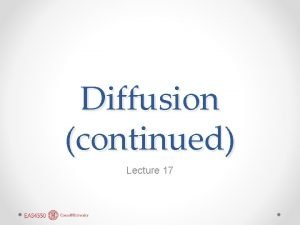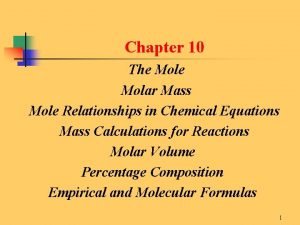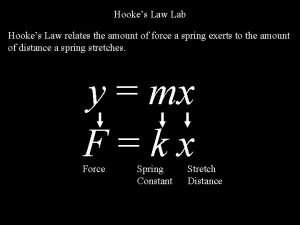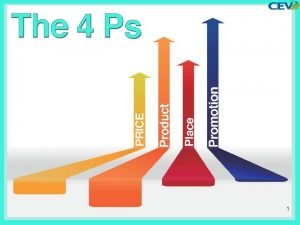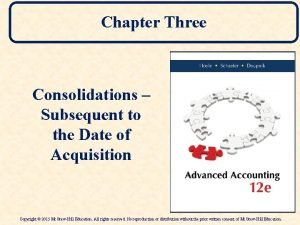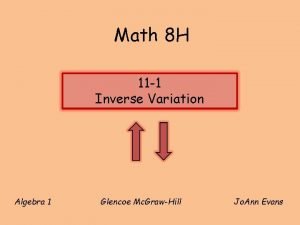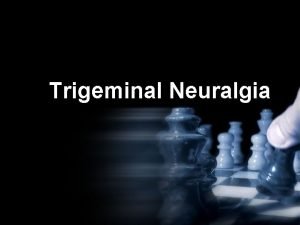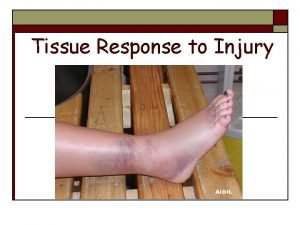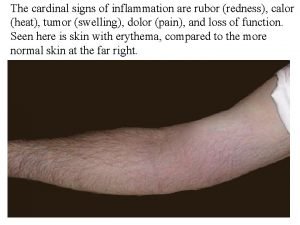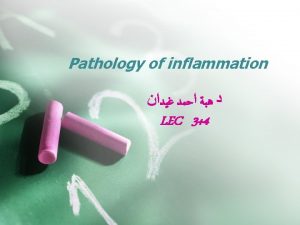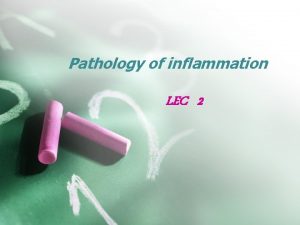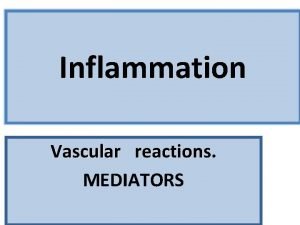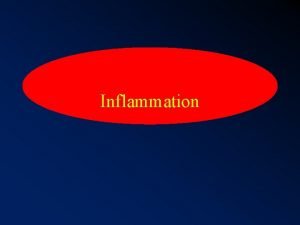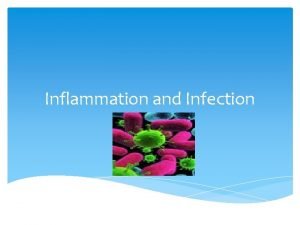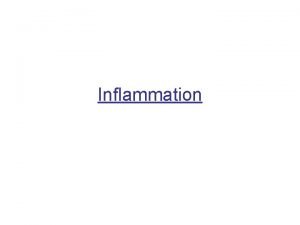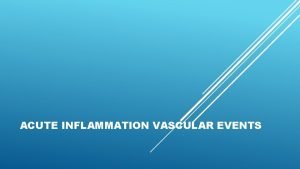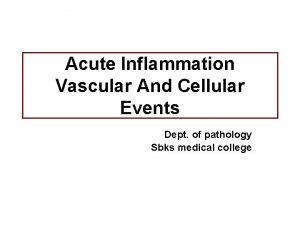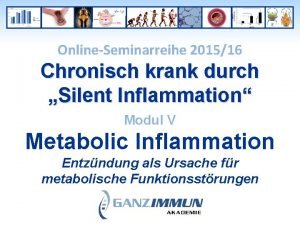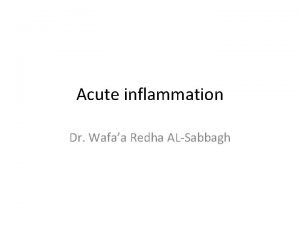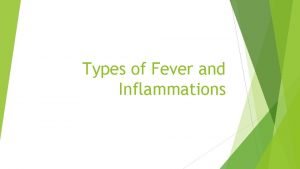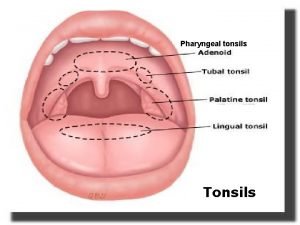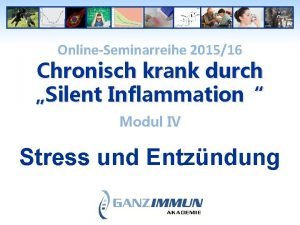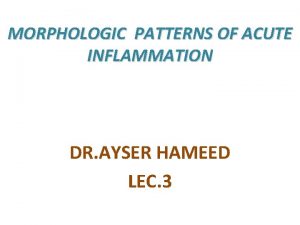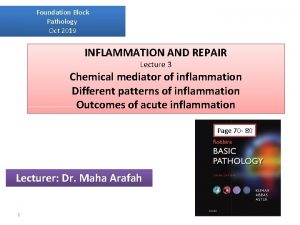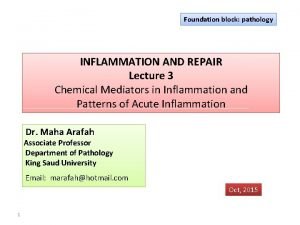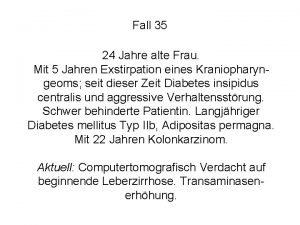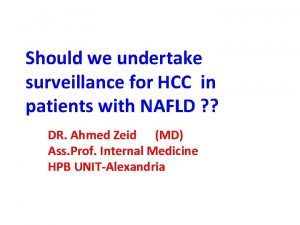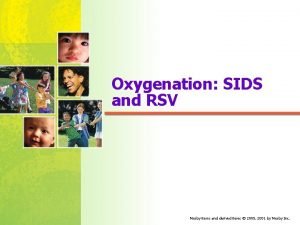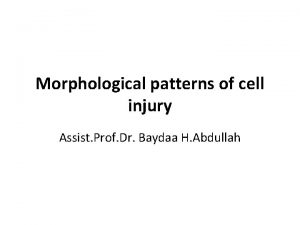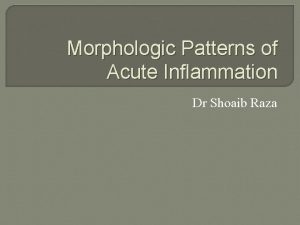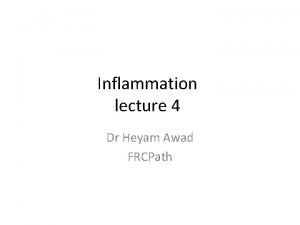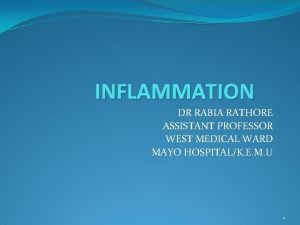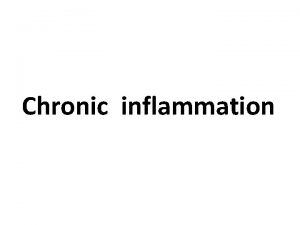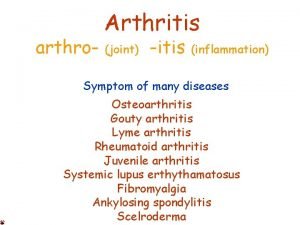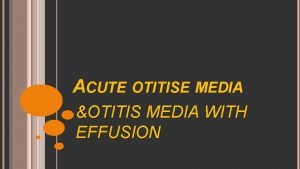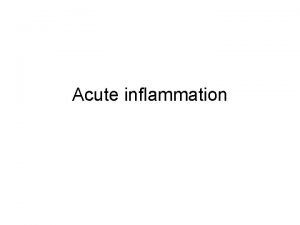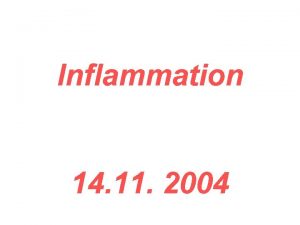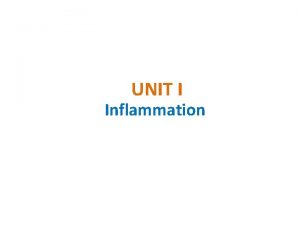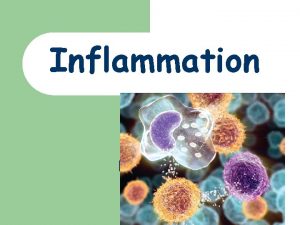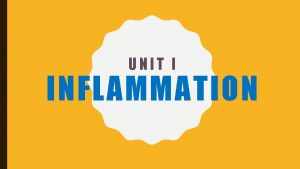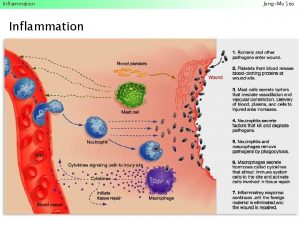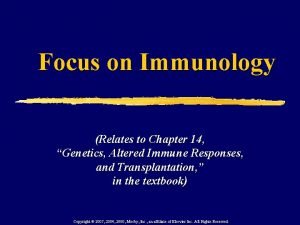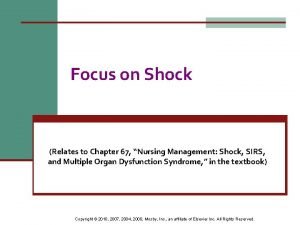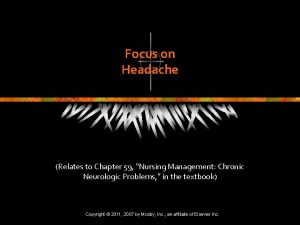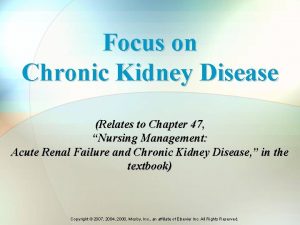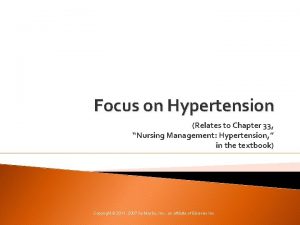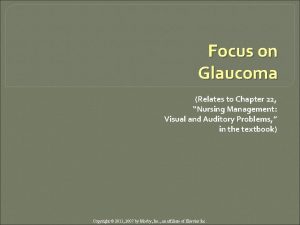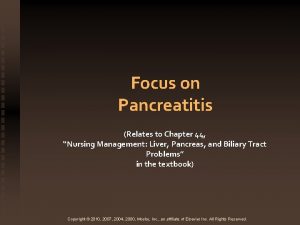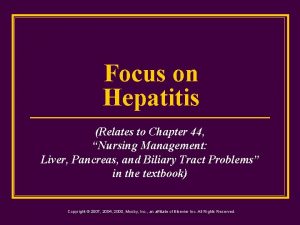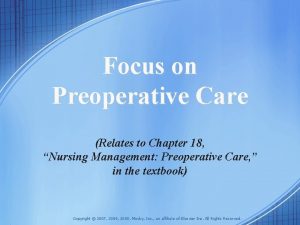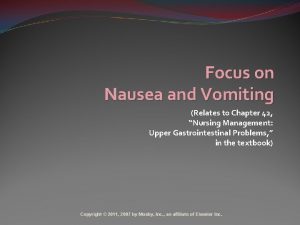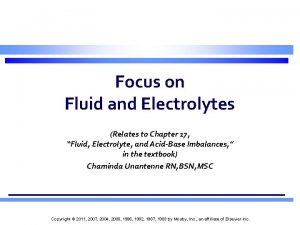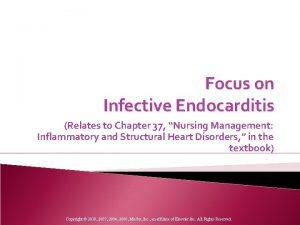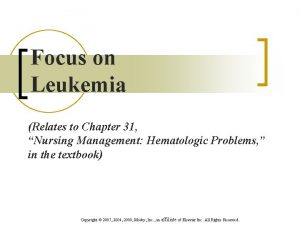Focus on Inflammation Relates to Chapter 13 Inflammation























































- Slides: 55

Focus on Inflammation (Relates to Chapter 13, “Inflammation and Wound Healing, ” in the textbook) Copyright © 2007, 2004, 2000, Mosby, Inc. , an affiliate of Elsevier Inc. All Rights Reserved.

Inflammatory Response n Sequential response to cell injury Neutralizes and dilutes inflammatory agent n Removes necrotic materials n Establishes an environment suitable for healing and repair n Copyright © 2007, 2004, 2000, Mosby, Inc. , an affiliate of Elsevier Inc. All Rights Reserved.

Inflammatory Response Mechanism of inflammation basically same regardless of injuring agent n Inflammation is always present with infection n Infection is not always present with inflammation n Copyright © 2007, 2004, 2000, Mosby, Inc. , an affiliate of Elsevier Inc. All Rights Reserved.

Inflammatory Response n Causes Heat n Radiation n Trauma n Allergens n Infection n Copyright © 2007, 2004, 2000, Mosby, Inc. , an affiliate of Elsevier Inc. All Rights Reserved.

Inflammatory Response n Intensity of the response depends on Extent and severity of injury n Reactive capacity of injured person n Copyright © 2007, 2004, 2000, Mosby, Inc. , an affiliate of Elsevier Inc. All Rights Reserved.

Inflammatory Response n Inflammatory response can be divided into Vascular response n Cellular response n Formation of exudate n Healing n Copyright © 2007, 2004, 2000, Mosby, Inc. , an affiliate of Elsevier Inc. All Rights Reserved.

Inflammatory Response Vascular Response After cell injury, arterioles in area briefly undergo transient vasoconstriction n After release of histamine and other chemicals by the injured cells, vessels dilate resulting in hyperemia n Copyright © 2007, 2004, 2000, Mosby, Inc. , an affiliate of Elsevier Inc. All Rights Reserved.

Vascular Response Cell injury Cell death Release of kinins, histamine, prostaglandins Momentary local vasoconstriction Local vasodilation Hyperemia FIG. 13 -1 Capillary permeability Fluid exudate Copyright © 2007, 2004, 2000, Mosby, Inc. , an affiliate of Elsevier Inc. All Rights Reserved.

Inflammatory Response Vascular Response n Vasodilation Results in hyperemia n Increased blood flow in the area n Raises filtration pressure n Copyright © 2007, 2004, 2000, Mosby, Inc. , an affiliate of Elsevier Inc. All Rights Reserved.

Inflammatory Response Vascular & Chemical Response n Vasodilation chemical mediators Endothelial cell retraction n Increased capillary permeability n Movement of fluid from capillaries into tissue spaces n Copyright © 2007, 2004, 2000, Mosby, Inc. , an affiliate of Elsevier Inc. All Rights Reserved.

Inflammatory Response Vascular Response n Fluid in tissue spaces Initially composed of serous fluid n Later contains plasma proteins, primarily albumin n Proteins exert oncotic pressure that further draws fluid from blood vessels n Tissue becomes edematous n Copyright © 2007, 2004, 2000, Mosby, Inc. , an affiliate of Elsevier Inc. All Rights Reserved.

Inflammatory Response Vascular Response As plasma protein fibrinogen leaves blood, it is activated to fibrin by products of the injured cells n Fibrin strengthens a blood clot formed by platelets n In tissue, clots trap bacteria to prevent spread n Copyright © 2007, 2004, 2000, Mosby, Inc. , an affiliate of Elsevier Inc. All Rights Reserved.

Inflammatory Response Cellular Response Blood flow through capillaries in the area of inflammation slows as fluid is lost and viscosity increases n Neutrophils and monocytes move to the inner surface of the capillaries and then migrate through the capillary wall to the site of the injury n Copyright © 2007, 2004, 2000, Mosby, Inc. , an affiliate of Elsevier Inc. All Rights Reserved.

Inflammatory Response Cellular Response n Chemotaxis Directional migration of WBCs along concentration gradient of chemotactic factors n Mechanism for accumulating neutrophils and monocytes at site of injury n Copyright © 2007, 2004, 2000, Mosby, Inc. , an affiliate of Elsevier Inc. All Rights Reserved.

Margination, Diapedesis, and Chemotaxis FIG. 13 - 3 Copyright © 2007, 2004, 2000, Mosby, Inc. , an affiliate of Elsevier Inc. All Rights Reserved.

Inflammatory Response Cellular Response n Chemotactic factors Bacterial-derived n Complement-derived (C 5 a, C 3 a) n Lipid-derived n Platelet-derived n Coagulation-related n Chemokines n Copyright © 2007, 2004, 2000, Mosby, Inc. , an affiliate of Elsevier Inc. All Rights Reserved.

Inflammatory Response Cellular Response n Neutrophils First leukocytes to arrive at site of injury (6 to 12 hours) n Phagocytize bacteria, other foreign material, and damaged cells n Short life span (24 to 48 hours) n Copyright © 2007, 2004, 2000, Mosby, Inc. , an affiliate of Elsevier Inc. All Rights Reserved.

Inflammatory Response Cellular Response n Neutrophils n Pus is composed of Dead neutrophils accumulated at the site of injury n Digested bacteria n Other cell debris n Copyright © 2007, 2004, 2000, Mosby, Inc. , an affiliate of Elsevier Inc. All Rights Reserved.

Inflammatory Response Cellular Response n Neutrophils n Bone marrow releases more neutrophils in response to infection resulting in elevated WBC Copyright © 2007, 2004, 2000, Mosby, Inc. , an affiliate of Elsevier Inc. All Rights Reserved.

Inflammatory Response Cellular Response n Monocytes Second type of phagocytic cells to migrate to site of injury from circulating blood n Attracted to the site by chemotactic factors n Arrive within 3 to 7 days after the onset of inflammation n Copyright © 2007, 2004, 2000, Mosby, Inc. , an affiliate of Elsevier Inc. All Rights Reserved.

Inflammatory Response Cellular Response n Monocytes On entering tissue spaces, monocytes transform into macrophages n Assist in phagocytosis of inflammatory debris n Macrophages have a long life span and can multiply n Copyright © 2007, 2004, 2000, Mosby, Inc. , an affiliate of Elsevier Inc. All Rights Reserved.

Inflammatory Response Cellular Response n Macrophage Important in cleaning the area before healing can occur n May stay in damaged tissues for weeks n Cells may fuse to form a multinucleated giant cell n Copyright © 2007, 2004, 2000, Mosby, Inc. , an affiliate of Elsevier Inc. All Rights Reserved.

Inflammatory Response Cellular Response n Lymphocytes Arrive later at the site of injury n Primary role of lymphocytes involve n Cell-mediated immunity n Humoral immunity n Copyright © 2007, 2004, 2000, Mosby, Inc. , an affiliate of Elsevier Inc. All Rights Reserved.

Cellular Response in Inflammation FIG. 13 - 2 Copyright © 2007, 2004, 2000, Mosby, Inc. , an affiliate of Elsevier Inc. All Rights Reserved.

Inflammatory Response Cellular Response n Eosinophils Released in large quantities during an allergic reaction n Release chemicals that act to control the effects of histamine and serotonin n Involved in phagocytosis of allergen– antibody complex n Copyright © 2007, 2004, 2000, Mosby, Inc. , an affiliate of Elsevier Inc. All Rights Reserved.

Inflammatory Response Cellular Response n Basophils Carry histamine and heparin in their granules that are released during inflammation n Have limited phagocytic capabilities n Copyright © 2007, 2004, 2000, Mosby, Inc. , an affiliate of Elsevier Inc. All Rights Reserved.

Inflammatory Response Cellular Response n Chemical mediators Histamine n Serotonin n Kinins (e. g. , bradykinin) n Copyright © 2007, 2004, 2000, Mosby, Inc. , an affiliate of Elsevier Inc. All Rights Reserved.

Inflammatory Response Cellular Response n Chemical mediators Complement components (C 3 a, C 4 a, C 5 a) n Prostaglandins and leukotrienes n Cytokines n Copyright © 2007, 2004, 2000, Mosby, Inc. , an affiliate of Elsevier Inc. All Rights Reserved.

Inflammatory Response Cellular Response n Complement system Major mediator of the inflammatory response n When activated, the components occur in sequential order involving two pathways n Each activated complex can act on the next component n Copyright © 2007, 2004, 2000, Mosby, Inc. , an affiliate of Elsevier Inc. All Rights Reserved.

Inflammatory Response Complement System FIG. 13 - 4 Copyright © 2007, 2004, 2000, Mosby, Inc. , an affiliate of Elsevier Inc. All Rights Reserved.

Inflammatory Response Cellular Response n Major functions of the complement system Enhanced phagocytosis n Increased vascular permeability n Chemotaxis n Cellular lysis n Copyright © 2007, 2004, 2000, Mosby, Inc. , an affiliate of Elsevier Inc. All Rights Reserved.

Inflammatory Response Cellular Response n Major functions of the complement system Enhanced phagocytosis n Increased vascular permeability n Chemotaxis n Cellular lysis n Copyright © 2007, 2004, 2000, Mosby, Inc. , an affiliate of Elsevier Inc. All Rights Reserved.

Inflammatory Response Cellular Response n Complement system Activation increases phagocytosis through opsonization and chemotaxis n The entire complement sequence of C 1 to C 9 must be activated for cell lysis to occur n Copyright © 2007, 2004, 2000, Mosby, Inc. , an affiliate of Elsevier Inc. All Rights Reserved.

Inflammatory Response Cellular Response n Complement system (cont’d) n C 8 and C 9, the final components of the complement system, pierce the cell surface, causing rupture of the cell membrane and lysis Copyright © 2007, 2004, 2000, Mosby, Inc. , an affiliate of Elsevier Inc. All Rights Reserved.

Inflammatory Response Cellular Response n Prostaglandins Synthesized from the phospholipids of cell membranes of most body tissues, including blood cells n Phospholipids are converted to arachidonic acid, which is then oxidized by two different pathways n Copyright © 2007, 2004, 2000, Mosby, Inc. , an affiliate of Elsevier Inc. All Rights Reserved.

Inflammatory Response Cellular Response n Prostaglandins Series E and I prostaglandins are potent vasodilators and inhibit platelet and neutrophil aggregation n Prostaglandins are generally considered proinflammatory, contributing to increased blood flow, edema, and pain n Copyright © 2007, 2004, 2000, Mosby, Inc. , an affiliate of Elsevier Inc. All Rights Reserved.

Inflammatory Response Cellular Response n Prostaglandins n Drugs that inhibit prostaglandin synthesis Nonsteroidal anti-inflammatory drugs n Aspirin n Corticosteroids n Copyright © 2007, 2004, 2000, Mosby, Inc. , an affiliate of Elsevier Inc. All Rights Reserved.

Pathway of Arachidonic Acid Oxygenation FIG. 13 - 5 Copyright © 2007, 2004, 2000, Mosby, Inc. , an affiliate of Elsevier Inc. All Rights Reserved.

Inflammatory Response Cellular Response n Exudate Consists of fluid and leukocytes that move from the circulation to the site of injury n Nature and quantity depend on the type and severity of the injury and the tissues involved n Copyright © 2007, 2004, 2000, Mosby, Inc. , an affiliate of Elsevier Inc. All Rights Reserved.

Inflammatory Response Clinical Manifestations n Local response to inflammation Redness n Heat n Pain n Swelling n Loss of function n Copyright © 2007, 2004, 2000, Mosby, Inc. , an affiliate of Elsevier Inc. All Rights Reserved.

Inflammatory Response Clinical Manifestations n Systemic response to inflammation Increased WBC count with a shift to the left n Malaise n Nausea and anorexia n Increased pulse and respiratory rate n Fever n Copyright © 2007, 2004, 2000, Mosby, Inc. , an affiliate of Elsevier Inc. All Rights Reserved.

Inflammatory Response Clinical Manifestations n Systemic response to inflammation The causes of the systemic response are poorly understood, but it is probably due to complement activation and the release of cytokines n Some of the cytokines are IL-1, IL-6, and tumor necrosis factor n Copyright © 2007, 2004, 2000, Mosby, Inc. , an affiliate of Elsevier Inc. All Rights Reserved.

Inflammatory Response Clinical Manifestations n Systemic response to inflammation n Fever Onset is triggered by release of cytokines n Cytokines cause fever by initiating metabolic changes in the temperatureregulating center n Epinephrine released from the adrenal medulla increases metabolic rate n Copyright © 2007, 2004, 2000, Mosby, Inc. , an affiliate of Elsevier Inc. All Rights Reserved.

Inflammatory Response Clinical Manifestations n Systemic response to inflammation n Fever Patient then experiences chills and shivering n Body is hot yet person seeks warmth until the circulating temperature reaches core body temperature n Copyright © 2007, 2004, 2000, Mosby, Inc. , an affiliate of Elsevier Inc. All Rights Reserved.

Inflammatory Response Clinical Manifestations n Systemic response to inflammation n Fever n Beneficial aspects of fever include increased killing of microorganisms, increased phagocytosis, and increased proliferation of T lymphocytes Copyright © 2007, 2004, 2000, Mosby, Inc. , an affiliate of Elsevier Inc. All Rights Reserved.

Production of fever Fig. 10 -6 Copyright © 2007, 2004, 2000, Mosby, Inc. , an affiliate of Elsevier Inc. All Rights Reserved.

Inflammatory Response Types of Inflammation n Acute Healing occurs in 2 to 3 weeks, usually leaving no residual damage n Neutrophils are the predominant cell type at the site of inflammation n Copyright © 2007, 2004, 2000, Mosby, Inc. , an affiliate of Elsevier Inc. All Rights Reserved.

Inflammatory Response Types of Inflammation n Subacute n Has same features as acute inflammation but persists longer Copyright © 2007, 2004, 2000, Mosby, Inc. , an affiliate of Elsevier Inc. All Rights Reserved.

Inflammatory Response Types of Inflammation n Chronic May last for years n Injurious agent persists or repeats injury to site n Predominant cell types involved are lymphocytes and macrophages n May result from changes in immune system (e. g. , autoimmune disease) n Copyright © 2007, 2004, 2000, Mosby, Inc. , an affiliate of Elsevier Inc. All Rights Reserved.

Inflammatory Response Healing Process n Regeneration n Replacement of lost cells and tissues with cells of the same type Copyright © 2007, 2004, 2000, Mosby, Inc. , an affiliate of Elsevier Inc. All Rights Reserved.

Inflammatory Response Healing Process n Regeneration Ability to regenerate depends on cell type n Constantly dividing cells that rapidly regenerate n n Skin, bone marrow, lymphoid organs, as well as mucous membrane cells of the urinary, reproductive, and GI tracts Copyright © 2007, 2004, 2000, Mosby, Inc. , an affiliate of Elsevier Inc. All Rights Reserved.

Inflammatory Response Healing Process n Regeneration n Replacement of lost cells and tissues with cells of the same type n Stable cells such as liver, bone, kidney, and pancreas regenerate in response to injury Copyright © 2007, 2004, 2000, Mosby, Inc. , an affiliate of Elsevier Inc. All Rights Reserved.

Inflammatory Response Healing Process n Regeneration Permanent cells such as neurons, skeletal and cardiac muscle do not divide n Neurons are replaced by glial cells, and new neurons may be produced by stem cells n Skeletal and cardiac muscle will be repaired with scar tissue n Copyright © 2007, 2004, 2000, Mosby, Inc. , an affiliate of Elsevier Inc. All Rights Reserved.

Inflammatory Response Healing Process n Repair Healing as a result of lost cells being replaced with connective tissue n Repair is more complex than regeneration n Copyright © 2007, 2004, 2000, Mosby, Inc. , an affiliate of Elsevier Inc. All Rights Reserved.

Inflammatory Response Healing Process n Repair is the most common type of healing and usually results in scar formation Initial phase–lasts 3 to 5 days n Granulation phase–lasts from 5 days to 3 weeks n Maturation phase and scar contraction– from 7 days to several months or years n Copyright © 2007, 2004, 2000, Mosby, Inc. , an affiliate of Elsevier Inc. All Rights Reserved.
 Prolepsis
Prolepsis Porter's generic strategies
Porter's generic strategies Two fundamental business strategies are
Two fundamental business strategies are Actor focus vs object focus
Actor focus vs object focus What gas law relates pressure and temperature
What gas law relates pressure and temperature Section 13.2 the combined gas law and avogadro's principle
Section 13.2 the combined gas law and avogadro's principle Green's theorem vs stokes theorem
Green's theorem vs stokes theorem Fick's law
Fick's law Cl- molar mass
Cl- molar mass Hookes law lab
Hookes law lab If vince charged $200
If vince charged $200 Which of the 4 ps relates to packaging?
Which of the 4 ps relates to packaging? The formula c=5p+215 relates c
The formula c=5p+215 relates c Consolidation entry asterisk c relates to
Consolidation entry asterisk c relates to Vaidyanathan committee report related to revival of
Vaidyanathan committee report related to revival of Write an inverse variation equation that relates x and y
Write an inverse variation equation that relates x and y A proposition that relates two classes
A proposition that relates two classes Art in focus chapter 1 answers
Art in focus chapter 1 answers Trigeminal neuralgia
Trigeminal neuralgia 5 cardinal signs of inflammation
5 cardinal signs of inflammation Cardinal symptoms of inflammation
Cardinal symptoms of inflammation Morphological patterns of acute inflammation
Morphological patterns of acute inflammation Acute inflammation
Acute inflammation Morphological forms of inflammation
Morphological forms of inflammation Tromboflibitis
Tromboflibitis Stages of inflammation
Stages of inflammation Inflammation
Inflammation Cellular events of acute inflammation
Cellular events of acute inflammation Cellular events of acute inflammation
Cellular events of acute inflammation Acute inflammation definition
Acute inflammation definition 5 cardinal signs of inflammation
5 cardinal signs of inflammation Cardinal signs of acute inflammation
Cardinal signs of acute inflammation Chronic inflammation
Chronic inflammation Vascular response in acute inflammation
Vascular response in acute inflammation Cellular events of acute inflammation
Cellular events of acute inflammation übergewicht vla
übergewicht vla Dr el sabbagh
Dr el sabbagh F'
F' Lymphoid tissue of pharynx
Lymphoid tissue of pharynx Silent inflammation - chronisch krank
Silent inflammation - chronisch krank Morphologic patterns of acute inflammation
Morphologic patterns of acute inflammation Catarrhal inflammation
Catarrhal inflammation Sistema complemento funções
Sistema complemento funções Periportal inflammation
Periportal inflammation Cell injury and inflammation
Cell injury and inflammation Acute inflammation
Acute inflammation Inflammation of angle of mouth
Inflammation of angle of mouth Cell injury and inflammation
Cell injury and inflammation Morphological pattern of acute inflammation
Morphological pattern of acute inflammation Chemical mediators of inflammation
Chemical mediators of inflammation Serous inflammation examples
Serous inflammation examples Chronic inflammation
Chronic inflammation Necrosis
Necrosis Itis inflammation
Itis inflammation Acute inflammation
Acute inflammation Acute inflammatory exudate
Acute inflammatory exudate




